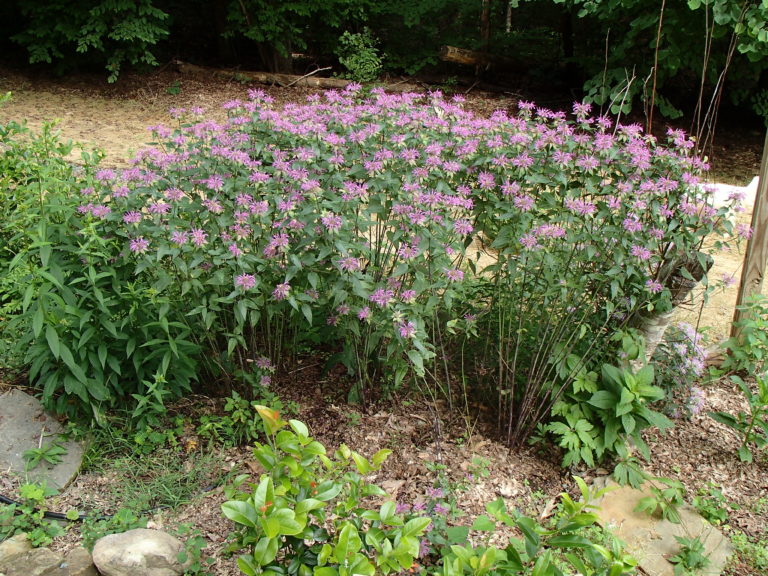Wild Bergamont is a fantastic wildflower native to almost every state in the country! Like other members of the mint family, it has square stems with coarsely toothed and slightly hairy opposite leaves. Wild Bergamont flowers are…well, kind of wild; they are lavender to pink, with irregular tubular petals, protruding from a disk sitting solitary at the end of branching stems, which in turn arise from a basal rosette. The flowers of Wild Bergamont look like something that came out of a Dr. Seuss book. Wild Bergamont attracts lots of butterflies, bees and hummingbirds, and the strong stems can be used by birds such as the Indigo Bunting to build their nests. Rhizomatous, it often spreads aggressively and is therefore easiest to grow in a natural area (wild garden). Wild Bergamont leaves can be used to brew a tea that tastes similar to mint. The 1993 Virginia Wildflower of the Year.
NURSERY HOURS
Wednesday: 10-4 Thursday: 10-6 Friday-Saturday: 10-4 Sunday: 12-4
Monarda fistulosa

Key Info
Scientific Name: Monarda fistulosa L.
Common Names: Wild Bergamot, Wild Beebalm, Wild Oregano, Horse Mint, Mintleaf Beebalm
Family Names: Lamiaceae (Mint) Family
Plant Type: Herbaceous perennial
Leaf Retention: Deciduous
Flower Color: Lavender
Additional Info
Habit: Wild Bergamot is an upright perennial with multiple smooth, green and square stems arising from a basal rosette. The stems branch frequently in the upper half and are topped with terminal flowers. The root system consists of deep, strongly branched roots, and shallow rhizomes that create colonies, sending up clusters of multiple leafy stems, giving Wild Bergamot a bushy appearance.
Height: 2'-4'
Spread: 2'-3'
Soil Conditions: Dry to moist, organically rich, well-drained soil; alkaline (pH>7.2), acidic (pH<6.8), circumneutral (pH 6.8-7.2); sand, loam, clay.
Leaves: Leaves are opposite, lance-shaped, and with toothed margins, 2-4 inches long and about twice as long as wide, rounded at the base and tapering to a pointed tip. They vary in color from light bluish green to dark green and exude an oregano scent. Stems, leaves and flowers have soft, spreading hairs, some plants being “fuzzier” than others.
Flowers (or reproductive structures: At the top of major stems are rounded heads (cymes) of lavender, fragrant, tubular flowers about 1.5 inches long x 1-3" across. Each cluster contains 20–50 1-inch florets with an irregular shape. The florets begin blooming in the center of the head outward, forming a wreath of florets. The tubes are pubescent with lobes toward the tip and exserted stamens and pistil which contribute to the ragged appearance of these flowers. The leaf-like bracts clustered just beneath the flower head are often tinged with pink. The blooming period occurs during mid-summer and lasts about 1 month.
Fruit: Flowers are followed in late summer/fall by ovoid nutlets that are nestled into the browned, button-like cymes. Four small nutlets form in the base of each calyx tube. The dry heads persist into the winter strewing seeds from the calyx cups
Natural Distribution: Rocky meadows, thickets and glade margins, open woods, roadside, prairies. Plants occur in high quality prairies type habitats but the durable rhizomes can also survive in disturbed sites.
USDA Hardiness Zone: 4 to 8
USDA Wetland Indicator Status in NC: UPL
Pollination: Butterflies, bees
Wildlife Connections: The nectar of the flowers attracts large numbers of native beees and bumble bees, long-tongued bees, bee flies, butterflies, skippers, and hummingbird moths. Sometimes Halictid bees collect pollen, while some wasps steal nectar by perforating the nectar tube. The Ruby-Throated Hummingbird also visits the flowers. The caterpillars of the Hermit Sphinx and Gray Marvel moths feed on the foliage. Small seed-eating birds like goldfinches and field sparrows perch precariously on swaying stems and pick out the seeds. Mammalian herbivores usually avoid this plant as a food source, probably because of the oregano-mint flavor of the leaves (Illinoiswildflowers.info).
Propagation: By division in spring or fall, by softwood cuttings in late spring, or seeds
